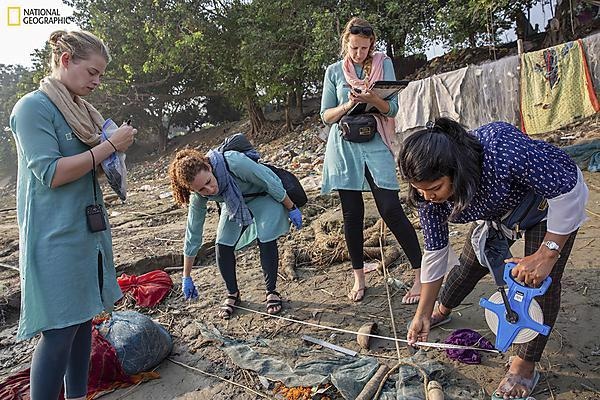Jan 25 2021
According to a new study, the Ganges River, including the combined flows of the Meghna and Brahmaputra rivers, could be accountable for the entry of up to 3 billion microplastic particles into the Bay of Bengal daily.
 Dr Imogen Napper (far left) helps survey fishing nets along the banks of the Ganges in Fatuha, Bihar. Image Credit: Sara Hylton, National Geographic.
Dr Imogen Napper (far left) helps survey fishing nets along the banks of the Ganges in Fatuha, Bihar. Image Credit: Sara Hylton, National Geographic.
The research constitutes the first-ever investigation of microplastic characteristics, abundance, and seasonal variation along the river and was performed with samples gathered by an international research group as part of the National Geographic Society’s Sea to Source: Ganges expedition.
As part of two expeditions in 2019, 120 samples (60 each in pre- and post-monsoon conditions) were collected at 10 sites by pumping river water via mesh filter to trap any particles.
Then, the samples were analyzed in labs at the University of Plymouth with microplastics discovered in 43 (71.6%) of the samples taken pre-monsoon and 37 (61.6%) taken post-monsoon.
Over 90% of the microplastics were fibers and, amongst them, acrylic (24%), and rayon (54%) —both of which are generally used in clothing—were the most plentiful ones.
Integrating anticipated microplastic concentration at the mouth of the river (Bhola in Bangladesh) with the discharge of the river, researchers predict that about 1 to 3 billion microplastics may be liberated from the Ganges Brahmaputra Meghna River Basin on a daily basis.
The study published in the journal Environmental Pollution was guided by scientists from the University of Plymouth’s International Marine Litter Research Unit, together with collaborators from the Wildlife Institute of India, University of Dhaka, WildTeam, University of Exeter, National Geographic Society, and the Zoological Society of London.
Globally, it has been estimated that 60 billion pieces of plastic are discharged into the ocean from rivers worldwide each day. However, what has been lacking until now has been a detailed analysis of how microplastic concentrations vary along a river’s course.
Dr Imogen Napper, Study Lead Author, Research Fellow and National Geographic Explorer, University of Plymouth
“By working with local communities and partners, this expedition always aimed to help us stem the flow of plastic entering the Ganges. These results provide the first step in understanding how it, as well as other major rivers, may contribute to oceanic microplastic,” added Napper.
Napper was one of the participants of the Sea to Source: Ganges expedition.
The Ganges River emerges in the Himalayas and runs via India and Bangladesh, where it combines with the Meghna and Brahmaputra rivers briefly before arriving at the Indian Ocean.
In South Asia, the integrated flows of the three rivers are the largest, and it forms the denser basin in the world, with more than 655 million inhabitants depending on the water it supplies.
The samples were gathered at the time of pre-monsoon (May to June 2019) and post-monsoon (October to December 2019), at sites varying from Harsil next to the source of the Ganges to Bhola in southern Bangladesh where it joins the Bay of Bengal.
The sample sites were chosen to guarantee a combination of urban, agricultural, rural, religious, and tourism locations, with the huge concentrations found next to the river’s mouth situated at Bhola, in Bangladesh.
Pre-monsoon samples that were gathered in Bhola had four times as many particles as those collected at Harsil, whereas the post-monsoon samples had double the quantity.
We know that rivers are a substantial source of microplastics in the ocean. But the information like this can help identify the key sources and pathways of microplastic and hence inform management interventions. With this type of evidence, we can progress toward using plastics more responsibly so as to get the many benefits they can bring without unnecessary contamination of the environment.
Richard Thompson, OBE, Study Co-Author, Professor, and Head, International Marine Litter Research Unit, University of Plymouth
Journal Reference:
Napper, I. E., et al. (2021) The abundance and characteristics of microplastics in surface water in the transboundary Ganges River. Environmental Pollution. doi.org/10.1016/j.envpol.2020.116348.